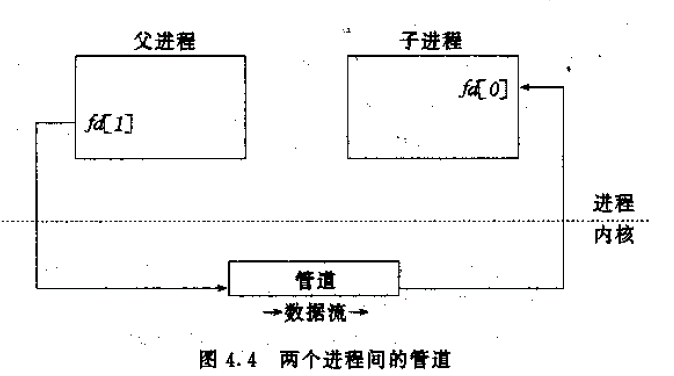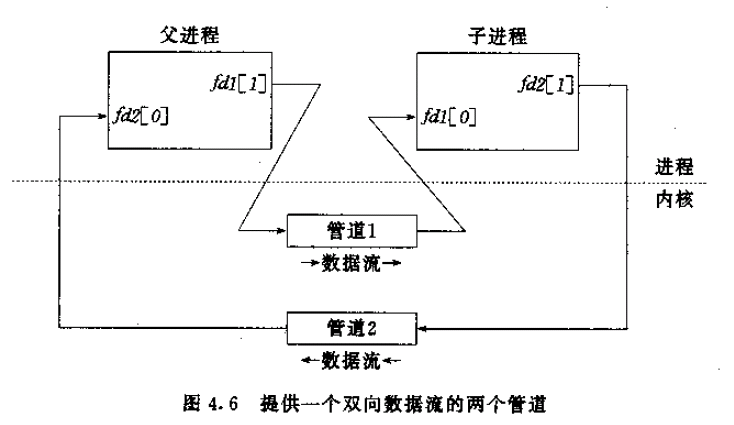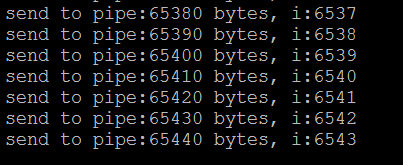基本概念:
linux管道(也叫无名管道)由pipe函数创建,提供一个单路(单向)数据流。(注:linux不支持全双工的管道,某些系统支持)
PIPE(2) Linux Programmer's Manual PIPE(2)
NAME
pipe, pipe2 - create pipe
SYNOPSIS
#include <unistd.h>
int pipe(int pipefd[2]);
该函数返回两个文件描述符:fd[0]和fd[1]。前者打开来读,后者打开来写。
管道的典型用途是以下述方式为两个不同进程(一个是父进程,一个是子进程)提供进程间通信的手段。首先,由一个进程(它将成为父进程)创建一个管道后调用fork派生一个自身的副本,如图4-3所示:
接着,父进程关闭这个管道的读出端,子进程关闭同一管道的写入端。这就在父子进程间提供了一个单向数据流,如图4-4所示:
我们在某个shell中输入一个像下面这样的命令时:
who | sort | lp
该shell将执行上述步骤创建三个进程和其间的两个管道。它还把每个管道的读出端复制到相对应进程的标准输入,把每个管道的写入端复制到相应进程的标准输出。图4-5展示了这样的管道线:
到此为止所示的所有管道都是半双工的即单向的,只提供一个方向的数据流。当需要一个双向数据流时,我们必须创建两个管道,每个方向一个。实际步骤如下:
(1)创建管道1(fd1[0]和fd1[0])和管道2(fd2[0]和fd2[0])
(2)fork
(3)父进程关闭管道1的读出端(fd1[0])
(4)父进程关闭管道2的写入端(fd2[1])
(5)子进程关闭管道1的写入端(fd1[1])
(6)子进程关闭管道2的读出端(fd2[0])
它产生如图4-6所示的管道布局
例子1,提供一个双向数据流的两个管道,这里的pipe返回的文件描述符默认是阻塞模式。
gcc pipe.c
#include <unistd.h>
#include <stdio.h>
#include <errno.h>
#include <stdlib.h>
#include <sys/types.h>
#include <sys/wait.h>
#include <string.h>
#define MAXLINE 1024
void Perror(const char *s)
{
perror(s);
exit(EXIT_FAILURE);
}
void client(int readfd, int writefd)
{
/* read msg */
int i = 0;
for (i; i<3; i++) {
char buff[MAXLINE] = {0};
int n = read(readfd, buff, MAXLINE);
if (n > 0) {
printf("read from server:%s\n", buff);
}
}
char *buff = "goodby server";
write(writefd, buff, strlen(buff));
}
void server(int readfd, int writefd)
{
/* send msg */
int i = 0;
for (i; i<3; i++) {
char buff[MAXLINE] = {0};
sprintf(buff, "hello world %d", i);
int n = write(writefd, buff, strlen(buff));
//printf("send to client:%d bytes\n", n);
sleep(1);
}
char buff[MAXLINE] = {0};
int n = read(readfd, buff, MAXLINE);
if (n > 0) {
printf("read from client:%s\n", buff);
}
}
int main()
{
int pipe1[2], pipe2[2];
pid_t childpid;
if (pipe(pipe1) == -1) {
Perror("create pipe1 failed");
}
if (pipe(pipe2) == -1) {
Perror("create pipe2 failed");
}
childpid = fork();
if (childpid == 0) { /* child */
close(pipe1[1]);
close(pipe2[0]);
server(pipe1[0], pipe2[1]);
exit(0);
}
close(pipe1[0]);
close(pipe2[1]);
client(pipe2[0], pipe1[1]);
/* parent */
waitpid(childpid, NULL, 0);
return 0;
}例子1运行结果:
关于管道的大小,可以通过ulimit -a或者ulimit -p命令查看,显示结果为512*8=4kb,实际值并不是这个,后面通过实验证明。
例子2,管道大小的测试
gcc pipe_size.c
#include <unistd.h>
#include <stdio.h>
#include <errno.h>
#include <stdlib.h>
#include <sys/types.h>
#include <sys/wait.h>
#include <string.h>
#define MAXLINE 1024
void Perror(const char *s)
{
perror(s);
exit(EXIT_FAILURE);
}
void client(int readfd, int writefd)
{
/* read msg */
int i = 0;
while (1) {
sleep(1);
}
}
void server(int readfd, int writefd)
{
/* read msg */
int i = 0;
int sum = 0;
for (i; i<=1000000; i++) {
char buff[MAXLINE] = "0123456789";
int n = write(writefd, buff, strlen(buff));
sum += n;
printf("send to pipe:%d bytes, i:%d\n", sum, i);
}
}
int main()
{
int pipe1[2], pipe2[2];
pid_t childpid;
if (pipe(pipe1) == -1) {
Perror("create pipe1 failed");
}
if (pipe(pipe2) == -1) {
Perror("create pipe2 failed");
}
childpid = fork();
if (childpid == 0) { /* child */
close(pipe1[1]);
close(pipe2[0]);
server(pipe1[0], pipe2[1]);
exit(0);
}
close(pipe1[0]);
close(pipe2[1]);
client(pipe2[0], pipe1[1]);
/* parent */
waitpid(childpid, NULL, 0);
return 0;
}
例子2运行结果:
分析运行结果发现,管道的size与ulimit返回的结果并不相符合。实际上管道的大小是64kb,这也与测试结果吻合。
管道大小的分析文章,可以参考:http://blog.csdn.net/judwenwen2009/article/details/44134415
关于数据持久性:当一个管道或FIFO的最后一次关闭发生时,仍在该管道或FIFO上的数据将被丢弃。
关于更多:IPC之管道和FIFO的额外属性
参考:《unix网络编程》·卷2
End;





























 225
225

 被折叠的 条评论
为什么被折叠?
被折叠的 条评论
为什么被折叠?








